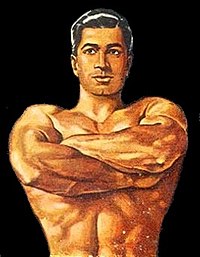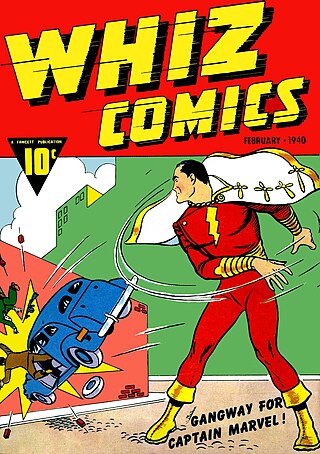
A superhero or superheroine is a stock character who typically possesses superpowers or abilities beyond those of ordinary people, is frequently costumed concealing their identity, and fits the role of the hero; typically using their powers to help the world become a better place, or dedicating themselves to protecting the public and fighting crime. Superhero fiction is the genre of fiction that is centered on such characters, especially, since the 1930s, in American comic books, as well as in Japanese media.
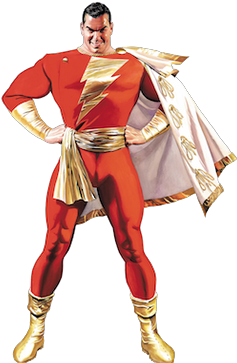
Captain Marvel, also known as Shazam and the Captain, is a superhero in American comic books originally published by Fawcett Comics and currently published by DC Comics. Artist C. C. Beck and writer Bill Parker created the character in 1939. Captain Marvel first appeared in Whiz Comics #2, published by Fawcett Comics. He is the alter ego of Billy Batson, a boy who, by speaking the magic word "Shazam!", is transformed into a costumed adult with the powers of superhuman strength, speed, flight, and other abilities. The character battles an extensive rogues' gallery, most of them working in tandem as the Monster Society of Evil, including primary archenemies Black Adam, Doctor Sivana and Mister Mind. Billy often shares his powers with other children, primarily his sister Mary Batson and their best friend/foster brother Freddy Freeman, who also transform into superheroes and fight crime with Billy as members of the Marvel Family, also known as the Shazam Family.

The Young All-Stars are a team of fictional DC Comics superheroes. They were created by Roy Thomas, Dann Thomas, and Michael Bair, and introduced in Young All-Stars #1, dated June 1987. The team members Tsunami, Neptune Perkins, and Dan the Dyna-Mite were all introduced in previously published DC Comics stories. The team members Iron Munro, Flying Fox, and Fury were created for the series and intended to be analogs of the Golden Age versions of Superman, Batman, and Wonder Woman respectively.
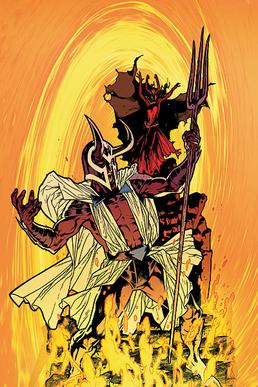
Blaze and Satanus are twin fictional demonic siblings appearing in American comic books published by DC Comics. Blaze first debuted in Action Comics #655, created by Roger Stern and Brett Breeding and first pencilled by Bob McLeod. Later, Satanus was created by Brett Breeding and debuted in The Adventures of Superman #493 by Jerry Ordway and Tom Grummett. The twin duo originally starred as Superman villains associated with the supernatural but were later revealed to be the children of the Wizard Shazam, Blaze respectively depicted as a powerful enemy of the Marvel Family.
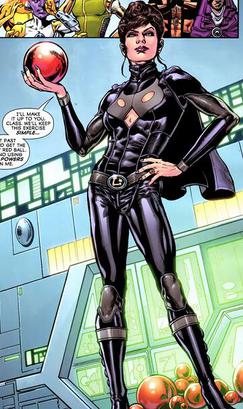
Night Girl is a fictional character appearing in media published by DC Comics, primarily as a member of the Legion of Super-Heroes and Legion of Substitute Heroes in the 30th and 31st centuries. She first appeared in Adventure Comics #306.
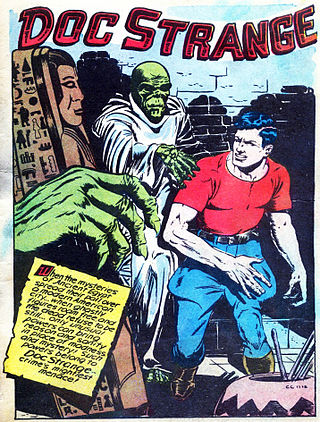
Doc Strange is a Golden Age comic book superhero who originally appeared in Thrilling Comics #1 in February 1940. The character continued in Thrilling Comics until issue #64. He also appeared in America's Best Comics #1-23 and 27.
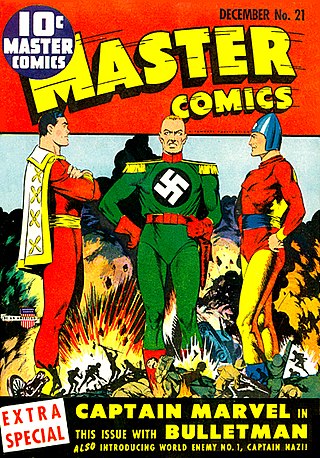
Captain Nazi is a Fawcett Comics and DC Comics supervillain, and rival of Captain Marvel and Captain Marvel Jr.
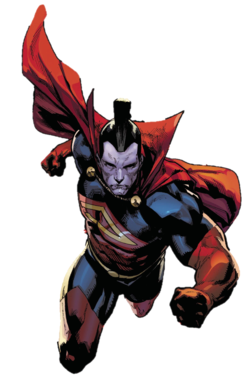
Gladiator is a fictional character appearing in American comic books published by Marvel Comics. He first appeared in The X-Men #107 and was created by writer Chris Claremont and artist Dave Cockrum. Gladiator, whose given name is Kallark, is a Strontian, and like others of his race has the capacity for great strength and various superpowers, but can only use them when he is completely devoted to a purpose; his abilities increase and decrease in accordance with his level of confidence. He was born on Strontia, which is part of the Shi'ar Empire and he is the leader of their Imperial Guard. He was also a member of the Annihilators, Dark Guardians, and Guardians of the Galaxy.

Gladiator is a science fiction novel by American author Philip Wylie, first published in 1930. The story concerns a scientist who invents an "alkaline free-radical" serum to "improve" humankind by granting the proportionate strength of an ant and the leaping ability of the grasshopper. The scientist injects his pregnant wife with the serum and his son Hugo Danner is born with superhuman strength, speed, and bulletproof skin. Hugo spends much of the novel hiding his powers, rarely getting a chance to openly use them.

Frog-Man is a comedic superhero appearing in American comic books published by Marvel Comics. Created by writer J. M. DeMatteis and artist Kerry Gammill, the character's costume is actually borrowed from a previously existing villain named Leap-Frog created in 1965 by writer Stan Lee and artist Gene Colan. Frog-Man was first introduced in the comic book series Marvel Team-Up in issue #121, published in June, 1982. The characters Eugene Patilio and Leap-Frog are both unrelated to the original Marvel villain called Frog-Man.
Kangaroo is the name of two fictional characters, supervillains appearing in American comic books published by Marvel Comics. Both are noted for their leaping ability.

Iron Munro is a superhero character appearing in American comic books published by DC Comics. Roy Thomas created the character in 1987 for Young All-Stars. He largely served to replace Superman in stories set during World War II after the Crisis on Infinite Earths storyline eliminated continuities in which Superman was active in this period.

Jax-Ur is a supervillain appearing in comic books published by DC Comics, usually as an adversary of Superman. Created by writer Otto Binder and artist George Papp, the character first appeared in Adventure Comics #289. He has been described as "the worst troublemaker in the Phantom Zone" and was the first criminal banished there.

Hercules is a fictional Olympian god in the DC Universe based on the Greek demigod and hero of the same name.

Wundarr the Aquarian is a fictional character appearing in American comic books published by Marvel Comics. The character was created by Steve Gerber and Val Mayerik and first appeared in Adventure into Fear #17. A pastiche of Superman, Wundarr was created based on Gerber's "love of the Superman character and (...) desire to do a little parody/homage".
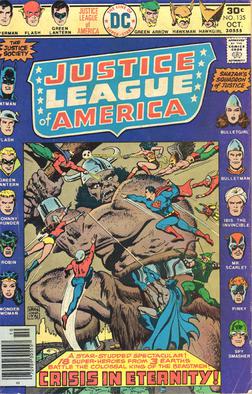
King Kull is a fictional character appearing in American comic books published originally by Fawcett Comics and currently by DC Comics. Created by Otto Binder and C. C. Beck, he originally first appeared in Fawcett Comics’ Captain Marvel Adventures in October 1951, and appeared from then until 1953 when the company ceased publishing its superhero titles. DC later acquired Fawcett's properties, and revived the character in the 1970s.

The origin of Superman and his superhuman powers have been a central narrative for Superman since his inception, with the story of the destruction of his home planet, his arrival on Earth and emergence as a superhero evolving from Jerry Siegel's original story into a broad narrative architype over the course of Superman's literary history and as the character's scope continues to expand across comics, radio, television and film.

Superhero fiction is a subgenre of speculative fiction examining the adventures, personalities and ethics of costumed crime fighters known as superheroes, who often possess superhuman powers and battle similarly powered criminals known as supervillains. The genre primarily falls between hard fantasy and soft science fiction in the spectrum of scientific realism. It is most commonly associated with American comic books, though it has expanded into other media through adaptations and original works.

The Gladiator is a 1938 American comedy and fantasy film starring Joe E. Brown, Dickie Moore and June Travis. The movie is an adaptation of Philip Gordon Wylie's 1930 novel Gladiator, which is often credited with having influenced the creation of Superman.

Olga Mesmer is a superpowered fictional character in a pulp magazine's comic strip published from 1937 to 1938. Like the newspaper comic-strip character Popeye (1929) and novelist Philip Wylie's protagonist Hugo Danner (1930), she is among the precursors of the archetypal comic-book superhero, Superman.
